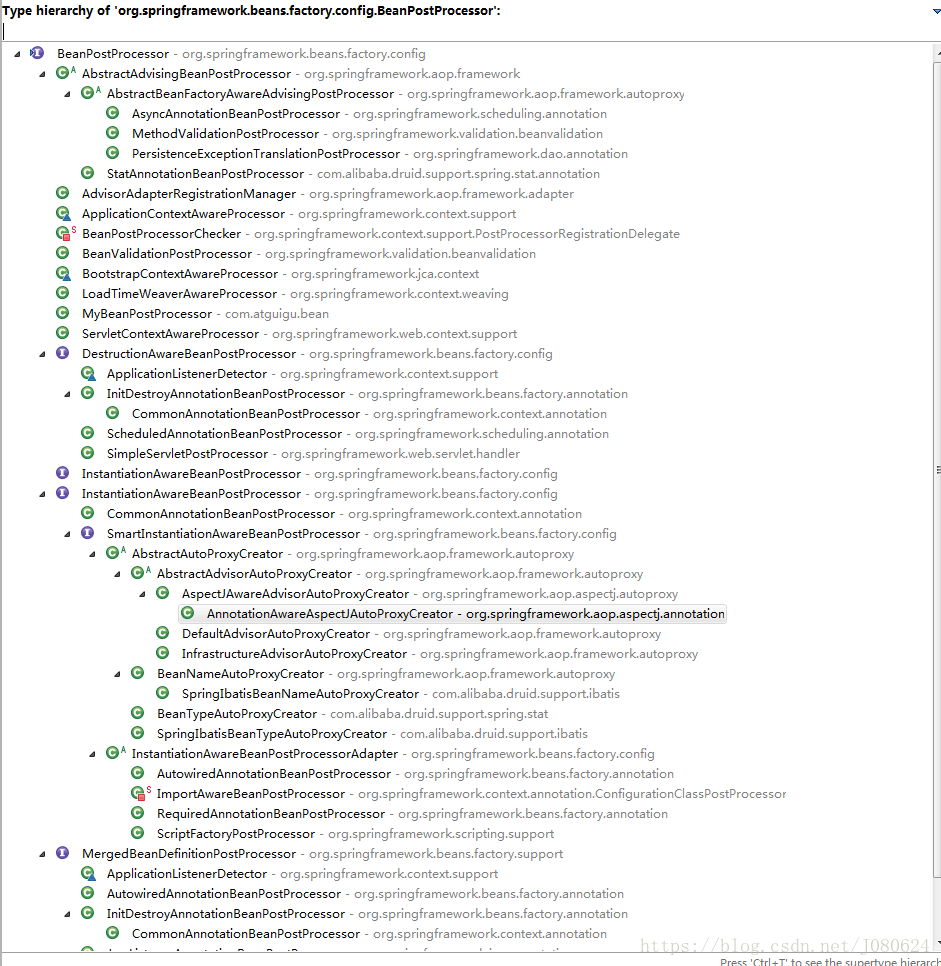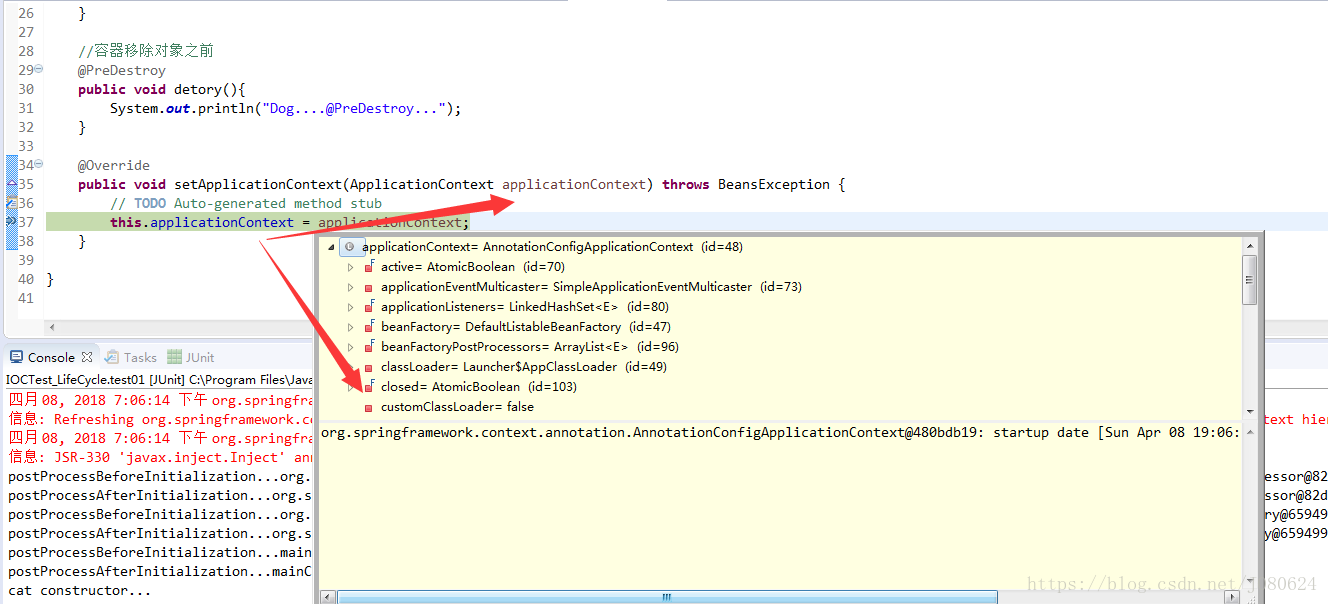如何初始化Spring中的bean?相信很多没有经验的人对此束手无策,为此本文总结了问题出现的原因和解决方法,通过这篇文章希望你能解决这个问题。
Bean的生命周期 : 创建bean对象 – 属性赋值 – 初始化方法调用前的操作 – 初始化方法 – 初始化方法调用后的操作 – …-- 销毁前操作 – 销毁方法的调用。
【1】init-method和destroy-method
自定义初始化方法和销毁方法两种方式:xml配置和注解。
① xml配置
<bean id="person" class="com.core.Person" scope="singleton" init-method="init" destroy-method="cleanUp" autowire="byName" lazy-init="true" > </bean>
② 注解配置
@Scope("singleton")
@Lazy
@Bean(name="person",initMethod="init",destroyMethod="cleanUp",
autowire=Autowire.BY_NAME)
public Person person01(){
return new Person("lisi", 20);
}单实例bean在容器创建完成前会进行创建并初始化,在容器销毁的时候进行销毁。多实例bean(scope=prototype)在第一次获取该bean实例时才会创建并初始化,且容器不负责该bean的销毁。
【2】InitializingBean 和DisposableBean
InitializingBean 接口:
public interface InitializingBean {
void afterPropertiesSet() throws Exception;
}在BeanFactory设置完bean属性后执行
需要被bean实现的接口,一旦bean的属性被BeanFactory设置后需要做出反应: 如,执行自定义初始化,或者仅仅是检查是否设置了所有强制属性。
实现InitializingBean 的可替代方式为给bean指定一个自定义的init-method,例如在一个xml bean 定义中。
在bean的属性设置之后进行操作,不返回任何值但是允许抛出异常。
DisposableBean接口:
public interface DisposableBean {
void destroy() throws Exception;
}被bean实现的接口,在销毁时释放资源,在Bean销毁的时候调用该方法。
如果销毁一个缓存的单例,一个BeanFactory 可能会调用这个销毁方法。
在容器关闭时,应用上下文会销毁所有的单例bean。
一种替代实现DisposableBean 接口的方案为指定一个自定义的destroy-method方法,例如在一个xml bean定义中。
自定义bean实现上述两个接口
@Component
public class Cat implements InitializingBean,DisposableBean {
public Cat(){
System.out.println("cat constructor...");
}
@Override
public void destroy() throws Exception {
// TODO Auto-generated method stub
System.out.println("cat...destroy...");
}
@Override
public void afterPropertiesSet() throws Exception {
// TODO Auto-generated method stub
System.out.println("cat...afterPropertiesSet...");
}
}测试结果
cat constructor...
cat...afterPropertiesSet...
容器创建完成...
四月 08, 2018 6:35:46 下午 org.springframework.context.annotation.AnnotationConfigApplicationContext
doClose
信息: Closing org.springframework.context.annotation.AnnotationConfigApplicationContext@11028347:
startup date [Sun Apr 08 18:35:46 CST 2018]; root of context hierarchy
cat...destroy...
【3】@PostConstruct和@PreDestroy
使用JSR250规范定义的两个注解:
@PostConstruct: PostConstruct注解作用在方法上,在依赖注入完成后进行一些初始化操作。这个方法在类被放入service之前被调用,所有支持依赖项注入的类都必须支持此注解。
@PreDestroy:在容器销毁bean之前通知我们进行清理工作
自定义类使用上述两个注解
@Component
public class Dog implements ApplicationContextAware {
//@Autowired
private ApplicationContext applicationContext;
public Dog(){
System.out.println("dog constructor...");
}
//对象创建并赋值之后调用
@PostConstruct
public void init(){
System.out.println("Dog....@PostConstruct...");
}
//容器移除对象之前
@PreDestroy
public void detory(){
System.out.println("Dog....@PreDestroy...");
}
@Override
public void setApplicationContext(ApplicationContext applicationContext) throws BeansException {
// TODO Auto-generated method stub
this.applicationContext = applicationContext;
}
}测试结果如下
dog constructor...
Dog....@PostConstruct...
容器创建完成...
四月 08, 2018 6:42:11 下午 org.springframework.context.annotation.AnnotationConfigApplicationContext
doClose
信息: Closing org.springframework.context.annotation.AnnotationConfigApplicationContext@11028347:
startup date [Sun Apr 08 18:42:10 CST 2018]; root of context hierarchy
Dog....@PreDestroy...
【4】BeanPostProcessor-Bean后置处理器
① 什么是bean后置处理器
在bean初始化前后进行一些处理工作
其接口源码如下:
public interface BeanPostProcessor {
Object postProcessBeforeInitialization(Object bean, String beanName) throws BeansException;
Object postProcessAfterInitialization(Object bean, String beanName) throws BeansException;
}自定义MyBeanPostProcessor实现该接口:
/**
* 后置处理器:初始化前后进行处理工作
* 将后置处理器加入到容器中
* @author lfy
*/
@Component
public class MyBeanPostProcessor implements BeanPostProcessor {
@Override
public Object postProcessBeforeInitialization(Object bean, String beanName) throws BeansException {
// TODO Auto-generated method stub
System.out.println("BeanPostProcessor.postProcessBeforeInitialization..."+beanName+"=>"+bean);
return bean;
}
@Override
public Object postProcessAfterInitialization(Object bean, String beanName) throws BeansException {
// TODO Auto-generated method stub
System.out.println("BeanPostProcessor.postProcessAfterInitialization..."+beanName+"=>"+bean);
return bean;
}
}② BeanPostProcessor原理
AbstractAutowireCapableBeanFactory中关于bean和BeanPostProcessor执行次序由上到下
//给bean进行属性赋值
populateBean(beanName, mbd, instanceWrapper);
//然后调用initializeBean方法
Object initializeBean(final String beanName, final Object bean, RootBeanDefinition mbd)
{
applyBeanPostProcessorsBeforeInitialization(wrappedBean, beanName);
//执行自定义初始化
invokeInitMethods(beanName, wrappedBean, mbd);
applyBeanPostProcessorsAfterInitialization(wrappedBean, beanName);
}AbstractAutowireCapableBeanFactory.initializeBean源码如下:
protected Object initializeBean(final String beanName, final Object bean, RootBeanDefinition mbd) {
if (System.getSecurityManager() != null) {
AccessController.doPrivileged(new PrivilegedAction<Object>() {
@Override
public Object run() {
invokeAwareMethods(beanName, bean);
return null;
}
}, getAccessControlContext());
}
else {
//调用意识/通知方法
invokeAwareMethods(beanName, bean);
}
Object wrappedBean = bean;
if (mbd == null || !mbd.isSynthetic()) {
//调用bean后置处理器的前置方法
wrappedBean = applyBeanPostProcessorsBeforeInitialization(wrappedBean, beanName);
}
//调用初始化方法
try {
invokeInitMethods(beanName, wrappedBean, mbd);
}
catch (Throwable ex) {
throw new BeanCreationException(
(mbd != null ? mbd.getResourceDescription() : null),
beanName, "Invocation of init method failed", ex);
}
if (mbd == null || !mbd.isSynthetic()) {
// //调用bean后置处理器的后置方法
wrappedBean = applyBeanPostProcessorsAfterInitialization(wrappedBean, beanName);
}
return wrappedBean;
}AbstractAutowireCapableBeanFactory.invokeInitMethods方法源码如下:
protected void invokeInitMethods(String beanName, final Object bean, RootBeanDefinition mbd)
throws Throwable {
boolean isInitializingBean = (bean instanceof InitializingBean);
if (isInitializingBean && (mbd == null || !mbd.isExternallyManagedInitMethod("afterPropertiesSet"))) {
if (logger.isDebugEnabled()) {
logger.debug("Invoking afterPropertiesSet() on bean with name '" + beanName + "'");
}
//调用InitializingBean.afterPropertiesSet
if (System.getSecurityManager() != null) {
try {
AccessController.doPrivileged(new PrivilegedExceptionAction<Object>() {
@Override
public Object run() throws Exception {
((InitializingBean) bean).afterPropertiesSet();
return null;
}
}, getAccessControlContext());
}
catch (PrivilegedActionException pae) {
throw pae.getException();
}
}
else {
((InitializingBean) bean).afterPropertiesSet();
}
}
//调用自定义初始化方法
if (mbd != null) {
String initMethodName = mbd.getInitMethodName();
if (initMethodName != null && !(isInitializingBean && "afterPropertiesSet".equals(initMethodName)) &&
!mbd.isExternallyManagedInitMethod(initMethodName)) {
invokeCustomInitMethod(beanName, bean, mbd);
}
}
}【5】Spring底层使用BeanPostProcessor
Spring框架底层存在大量BeanPostProcessor,如下图:

示例一 :BeanValidationPostProcessor是处理bean校验
其Javadoc如下:
/**
* Simple {@link BeanPostProcessor} that checks JSR-303 constraint annotations
* in Spring-managed beans, throwing an initialization exception in case of
* constraint violations right before calling the bean's init method (if any).
*
* @author Juergen Hoeller
* @since 3.0
*/
public class BeanValidationPostProcessor implements BeanPostProcessor, InitializingBean {
private Validator validator;
private boolean afterInitialization = false;
//...
}示例二:ApplicationContextAwareProcessor帮助获取容器上下文
其Javadoc如下:
/**
* {@link org.springframework.beans.factory.config.BeanPostProcessor}
* implementation that passes the ApplicationContext to beans that
* implement the {@link EnvironmentAware}, {@link EmbeddedValueResolverAware},
* {@link ResourceLoaderAware}, {@link ApplicationEventPublisherAware},
* {@link MessageSourceAware} and/or {@link ApplicationContextAware} interfaces.
*
* <p>Implemented interfaces are satisfied in order of their mention above.
*
* <p>Application contexts will automatically register this with their
* underlying bean factory. Applications do not use this directly.
*
* @author Juergen Hoeller
* @author Costin Leau
* @author Chris Beams
* @since 10.10.2003
* @see org.springframework.context.EnvironmentAware
* @see org.springframework.context.EmbeddedValueResolverAware
* @see org.springframework.context.ResourceLoaderAware
* @see org.springframework.context.ApplicationEventPublisherAware
* @see org.springframework.context.MessageSourceAware
* @see org.springframework.context.ApplicationContextAware
* @see org.springframework.context.support.AbstractApplicationContext#refresh()
*/
class ApplicationContextAwareProcessor implements BeanPostProcessor {
private final ConfigurableApplicationContext applicationContext;
private final StringValueResolver embeddedValueResolver;
//...
}如【3】中的dog类为例,其debug示意图如下:

【6】初始化和销毁方式测试
① 如果一个bean 综合应用下面六种种方式,执行顺序会怎样呢
Bean类如下:
public class Person implements InitializingBean,DisposableBean {
private String name;
private Integer age=1;
public Person(String name, Integer age) {
this.name = name;
this.age = age;
System.out.println("Person(String name, Integer age) constructor"+this);
}
public Person() {
super();
System.out.println("Person() constructor"+age);
}
public Integer getAge() {
return age;
}
public void setAge(Integer age) {
this.age = age;
}
public String getName() {
return name;
}
public void setName(String name) {
this.name = name;
}
@Override
public String toString() {
return "Person{" +
"name='" + name + '\'' +
", age=" + age +
'}';
}
// 自定义init方法
public void init(){
System.out.println("-----Person.init()-----"+this);
}
// 自定义销毁方法
public void cleanUp(){
System.out.println("-----Person.cleanUp()-----"+this);
}
// InitializingBean的实现方法
@Override
public void afterPropertiesSet() throws Exception {
System.out.println("-----InitializingBean.afterPropertiesSet()-----"+this);
}
//DisposableBean 的实现方法
@Override
public void destroy() throws Exception {
System.out.println("-----DisposableBean.destroy()-----"+this);
}
//对象创建并赋值之后调用
@PostConstruct
public void init2(){
System.out.println("-----@PostConstruct-----"+this);
}
//容器移除对象之前
@PreDestroy
public void destory2(){
System.out.println("-----@PreDestroy-----"+this);
}
}配置类如下:
public class Person implements InitializingBean,DisposableBean {
private String name;
private Integer age=1;
public Person(String name, Integer age) {
this.name = name;
this.age = age;
System.out.println("Person(String name, Integer age) constructor"+this);
}
public Person() {
super();
System.out.println("Person() constructor"+age);
}
public Integer getAge() {
return age;
}
public void setAge(Integer age) {
this.age = age;
}
public String getName() {
return name;
}
public void setName(String name) {
this.name = name;
}
@Override
public String toString() {
return "Person{" +
"name='" + name + '\'' +
", age=" + age +
'}';
}
// 自定义init方法
public void init(){
System.out.println("-----Person.init()-----"+this);
}
// 自定义销毁方法
public void cleanUp(){
System.out.println("-----Person.cleanUp()-----"+this);
}
// InitializingBean的实现方法
@Override
public void afterPropertiesSet() throws Exception {
System.out.println("-----InitializingBean.afterPropertiesSet()-----"+this);
}
//DisposableBean 的实现方法
@Override
public void destroy() throws Exception {
System.out.println("-----DisposableBean.destroy()-----"+this);
}
//对象创建并赋值之后调用
@PostConstruct
public void init2(){
System.out.println("-----@PostConstruct-----"+this);
}
//容器移除对象之前
@PreDestroy
public void destory2(){
System.out.println("-----@PreDestroy-----"+this);
}
}测试结果如下:
// 创建并初始化
Person(String name, Integer age) constructorPerson{name='lisi', age=20}
-----@PostConstruct-----Person{name='lisi', age=20}
-----InitializingBean.afterPropertiesSet()-----Person{name='lisi', age=20}
-----Person.init()-----Person{name='lisi', age=20}
//容器将要销毁
-----@PreDestroy-----Person{name='lisi', age=20}
-----DisposableBean.destroy()-----Person{name='lisi', age=20}
-----Person.cleanUp()-----Person{name='lisi', age=20}即,最先使用bean的构造器为bean属性赋值,接着JSR250规范定义的两个注解,其次是InitializingBean和DisposableBean接口,最后才是我们自定义的初始化方法和销毁方法。注意,这里还没有引入BeanPostProcessor。
② 在①的基础上添加BeanPostProcessor
实例化bean并进行初始化
//调用构造方法
Person(String name, Integer age) constructorPerson{name='lisi', age=20}
//bean初始化前
BeanPostProcessor.postProcessBeforeInitialization...person=>Person{name='lisi', age=20}
//初始化操作
-----@PostConstruct-----Person{name='lisi', age=20}
-----InitializingBean.afterPropertiesSet()-----Person{name='lisi', age=20}
-----Person.init()-----Person{name='lisi', age=20}
//bean初始化后操作
BeanPostProcessor.postProcessAfterInitialization...person=>Person{name='lisi', age=20}过程如下:类构造函数-->BeanPostProcessor-->@PostConstruct-->InitializingBean-->init()-->BeanPostProcessor
销毁bean
-----@PreDestroy-----Person{name='lisi', age=20}
-----DisposableBean.destroy()-----Person{name='lisi', age=20}
-----Person.cleanUp()-----Person{name='lisi', age=20}完整图示如下(同颜色的说明相对应):

在调用bean的构造函数时会根据入参为bean属性赋值,如果入参为空则会给bean属性赋予默认值,引用类型为null,基本类型比如int为0。
【7】 @Autowired注解的值何时放入?
如下所示,redisTemplate这个依赖何时被容器注入到RedisController中?

通过上面分析可知,依赖注入是在@PostConstruct注解的方法调用前被完成的(在populateBean()方法中被注入):

那么具体什么时候哪个类完成的 @Autowired注解注入依赖呢?
在类被实例化后由BeanPostProcessor完成的,哪个BeanPostProcessor?
具体是由AutowiredAnnotationBeanPostProcessor 完成的:

看完上述内容,你们掌握如何初始化Spring中的bean的方法了吗?如果还想学到更多技能或想了解更多相关内容,欢迎关注亿速云行业资讯频道,感谢各位的阅读!
免责声明:本站发布的内容(图片、视频和文字)以原创、转载和分享为主,文章观点不代表本网站立场,如果涉及侵权请联系站长邮箱:is@yisu.com进行举报,并提供相关证据,一经查实,将立刻删除涉嫌侵权内容。